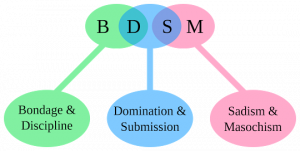
Bondage. is the practice of consensually tying, binding, or restraining a partner for erotic, aesthetic, or somatosensory stimulation.
Rope, cuffs, bondage tape, self-adhering bandage, or other any other physical restraints may be used for this purpose.
Bondage itself does not necessarily imply sadomasochism. Bondage may be used as an end into itself, as in the case of rope bondage and breast bondage.
It may also be used as a part of sex or in conjunction with other BDSMactivities. The letter “B” in the acronym “BDSM” comes from the word “bondage”. Sexuality and erotica are an important aspect in bondage, but are often not the end in itself. Aesthetics also plays an important role in bondage.
A common reason for the active partner to tie up their partner is so both may gain pleasure from the restrained partner’s submission, and the feeling of the temporary transfer of control and power.
For sadomasochistic people bondage is often used as a means to an end, where the restrained partner is more accessible to other sadomasochistic behaviour. However, bondage can also be used for its own sake. The restrained partner can derive sensual pleasure from the feeling of helplessness and immobility, and the active partner can derive visual pleasure and satisfaction from seeing their partner tied up.
Another type of bondage is mental bondage. This is where the Dominant instructs the submissive/bottom to be in a certain position and not be allowed to move.
Discipline in BDSM refers to the practice where the dominant sets rules for the submissive that he/she is expected to obey. When rules of expected behaviour are broken, punishment is often used as a means of disciplining.
Dominance and submission (also called D/s) is a set of behaviors, customs, and rituals involving the submission of one person to another in an erotic episode or lifestyle. It is a subset of BDSM.
Physical contact is not necessary, and D/s can be conducted anonymously over the telephone, email, or other messaging systems. In other cases, it can be intensely physical, sometimes crossing into sadomasochism.
In D/s, both parties take pleasure or erotic enjoyment from either dominating or being dominated. Those who take the superior position are called dominants—Doms (male) or Dommes (female)—while those who take the subordinate position are called submissives—or subs (male or female).
A switch is an individual who plays either role. Two switches together may negotiate and exchange roles several times in a session.
A dominatrix is usually a female sex worker who dominates others for pay.
It is common for writers to capitalise the “D” in Dominant but leave the “s” in lowercase for the submissive. Many extend this to His/Hers, Him/Her, He/She, etc., to make it clear when they are referring to a Dominant.
Sadomasochism is the giving or receiving pleasure from acts involving the receipt or infliction of pain or humiliation.
Practitioners of sadomasochism may seek sexual gratification from their acts.
While the terms sadist and masochist refer respectively to one who enjoys giving or receiving pain. Practitioners of sadomasochism may switch between activity and passivity.
The abbreviation S&M is often used for sadomasochism, although practitioners themselves normally remove the ampersand and use the acronym S-M or SM or S/M when written throughout the literature.
Sadomasochism is not considered a clinical paraphilia unless such practices lead to clinically significant distress or impairment for a diagnosis.
Similarly, sexual sadism within the context of mutual consent, generally known under the heading BDSM, is distinguished from non-consensual acts of sexual violence or aggression